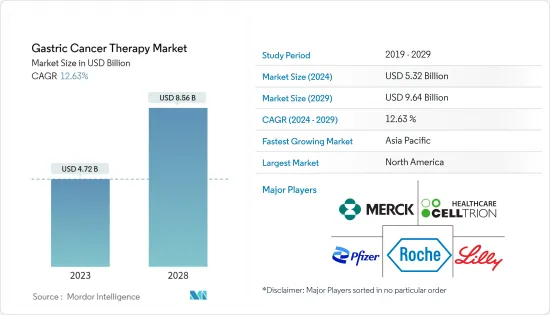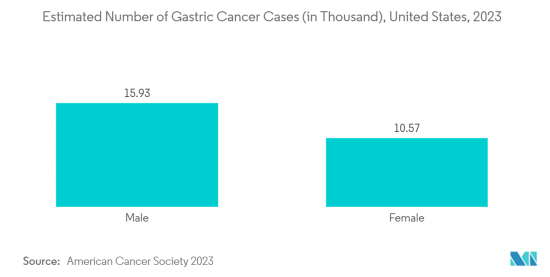PUBLISHER: Mordor Intelligence | PRODUCT CODE: 1403981

PUBLISHER: Mordor Intelligence | PRODUCT CODE: 1403981
Gastric Cancer Therapy - Market Share Analysis, Industry Trends & Statistics, Growth Forecasts 2024 - 2029

The Gastric Cancer Therapy Market size is estimated at USD 5.32 billion in 2024, and is expected to reach USD 9.64 billion by 2029, growing at a CAGR of 12.63% during the forecast period (2024-2029).
Key Highlights
- The COVID-19 pandemic affected healthcare systems globally and had a significant impact on the gastric cancer therapy market. Diagnosis and therapies for gastric cancer were delayed or canceled due to the global lockdown. For instance, as per the article published in March 2023 in PubMed, during the first year of the pandemic, the management of gastric cancer patients was globally affected by decreasing the frequency of multidisciplinary team meetings and the number of elective gastrectomies.
- During the COVID-19 pandemic, cancer patients were put at risk of adverse outcomes because of delays in diagnosis and treatment. As a result of the treatment and diagnosis delays, the pandemic had a substantial impact on market growth. However, the market has currently returned to its pre-pandemic state in relation to the demand for gastric cancer treatments.
- This is attributed to the elevated incidence of gastric cancer cases and several technological advancements. It is anticipated that the market will experience robust growth in the upcoming years.Certain factors that are propelling the market growth are the growing burden of gastric cancer and the introduction of novel therapies for metastatic cancer coupled with an increase in research and development activities by the key players.
- For instance, according to the Cancer Australia 2022 statistics, 2,572 new cases of stomach cancer were diagnosed in Australia (1,661 males and 911 females) in 2022. Thus, the high prevalence of stomach cancer is expected to increase the demand for gastric cancer therapies, thereby contributing to market growth. Thus, the rising burden of stomach cancer among the population is expected to raise the demand for effective treatment and therapies, which in turn is anticipated to fuel market growth.
- Furthermore, the rising company's focus on developing novel drugs and therapies for treating gastric cancer, coupled with increasing product launches, are all expected to boost the market growth over the forecast period. For instance, in November 2021, Natco Pharma launched a novel fixed-dose combination of Trifluridine and Tipiracil used to treat advanced colorectal and gastric cancer.
- Similarly, in February 2022, Ono Pharmaceutical Co., Ltd. and Bristol-Myers Squibb signed an outsourcing agreement with Prime Research Institute for Medical RWD, Inc. on an industry-sponsored, large-scale, multi-institutional clinical research in patients with gastric cancer treated with Opdivo in combination with chemotherapy.
- The study was conducted utilizing the PRiME-R's data input support system 'CyberOncology' which standardizes, structures, manages, and integrates real-world data in daily cancer clinical practice. Furthermore, in April 2022, BDR Pharmaceuticals launched Furmecil, a generic oral drug for the treatment of advanced gastric cancer. Thus, the emergence of various drugs to treat gastric cancer is expected to contribute to the growth of the market over the forecast period.
- Furthermore, in June 2023, Astellas Pharma submitted a New Drug Application (NDA) to Japan's Ministry of Health, Labour and Welfare (MHLW) for zolbetuximab, an investigational Claudin 18.2 (CLDN18.2)-targeted monoclonal antibody, indicated for the treatment of patients with locally advanced unresectable or metastatic HER2-negative gastric or gastroesophageal junction (GEJ) adenocarcinoma.
- Thus, due to the rise in gastric diseases and strategic activities coupled with research and development, the studied market is expected to witness significant growth over the forecast period. However, the high cost of cancer therapy and the side effects of drugs are likely to restrain the market growth over the forecast period.
Gastric Cancer Therapy Market Trends
Targeted Segment is Expected to Hold a Significant Share of the Market Over the Forecast Period
- Targeted therapy is a treatment used for cancer in which the drugs work by targeting the specific genes or proteins that are present in the cancer cells. There are several types of targeted therapies for cancers, such as hormone therapies, gene expression modulators, apoptosis inducers, angiogenesis inhibitors, signal transduction inhibitors, and many other therapies. Some of the targeted therapy drugs that are used to treat gastric cancer are ramucirumab, Bevacizumab, apatinib, sunitinib, trastuzumab, pertuzumab, lapatinib, and cetuximab.
- The targeted segment is expected to witness significant growth over the forecast period owing to factors such as the rising prevalence of gastric cancer among the population, increasing company activities in developing targeted therapies, and growing research studies related to targeted drugs and therapies.
- For instance, according to the article published in July 2022 in PubMed, the development of precision medicine has been consistently aided by the impressive advancements made in recent years in both domestic and international research on molecular targeted therapy in gastric cancer. Thus, an increase in targeted therapy research and development in gastric cancer is expected to bolster market growth over the forecast period. Moreover, the rising product launches and approvals are expected to increase segment growth.
- For instance, in November 2021, the Japan Pharmaceuticals and Medical Devices Agency (PMDA) approved Merck's KEYTRUDA as the first-line treatment for patients with radically unresectable, advanced, or recurrent esophageal carcinoma in combination with chemotherapy (5-fluorouracil [5-FU] plus cisplatin).
- Also, in April 2021, the Food Drug Administration (FDA) granted breakthrough therapy designation for investigational bemarituzumab as first-line treatment for patients with fibroblast growth factor receptor 2b (FGFR2b) overexpressing and human epidermal growth factor receptor 2 (HER2)-negative metastatic and locally advanced gastric and gastroesophageal (GEJ) adenocarcinoma in combination with modified FOLFOX6 (fluoropyrimidine, leucovorin, and oxaliplatin).
- Hence, the increase in cases of gastric cancer and the rise in product launches by the key players are expected to bolster the segment market growth over the forecast period.

North America is Expected to Occupy a Major Share of the Market Over the Forecast Period
North America is expected to hold a significant share in the gastric cancer therapy market over the forecast period owing to the factors such as the increasing prevalence of gastric cancer, rising adoption of targeted cancer therapy, and the availability of advanced technology in cancer research and treatment centers. For instance, according to the May 2021 update by the Canadian Cancer Society, 4,100 Canadians were diagnosed with gastric cancer in 2022.
Also, according to the American Cancer Society 2023 statistics, 26,500 cases are estimated to be diagnosed with stomach cancer in 2023 in the United States. Thus, the increasing number of gastric cancer cases in the region is expected to rise the demand for effective therapies for treating patients with gastric cancer which in turn is anticipated to fuel the market growth over the forecast period.
Furthermore, the rising company activities in conducting clinical trials for developing effective drugs for patients suffering from gastric cancer and increasing product launches and approvals in the region, are expected to fuel the market growth. For instance, in April 2021, the FDA approved Bristol Myers Squibb's Opdivo in combination with fluoropyrimidine and platinum-containing chemotherapy, for the treatment of patients with advanced or metastatic gastric cancer, gastroesophageal junction cancer, and esophageal adenocarcinoma.
Similarly, in January 2021, the FDA approved Enhertu for the treatment of adult patients with locally advanced or metastatic HER2-positive gastric or gastroesophageal junction (GEJ) adenocarcinoma. Similarly, in November 2022, Organon Canada launched Ontruzant, a biosimilar of the reference biologic Herceptin, providing patients in Canada with certain breast and gastric cancers with an additional therapeutic option at a lower cost.
Therefore, the increase in cases of gastric cancer and the rise in product launches by the key players are expected to bolster the market growth in the North American region.
Gastric Cancer Therapy Industry Overview
The gastric cancer therapy market is moderately competitive and consists of a few major players. In terms of shares, a few of the major players are currently dominating the market. Some of the major players in the market are F. Hoffmann-La Roche Ltd, Bristol-Myers Squibb, Pfizer, Merck & Co. Inc., and Celltrion Inc., among others.
Additional Benefits:
- The market estimate (ME) sheet in Excel format
- 3 months of analyst support
TABLE OF CONTENTS
1 INTRODUCTION
- 1.1 Study Assumptions and Market Definition
- 1.2 Scope of the Study
2 RESEARCH METHODOLOGY
3 EXECUTIVE SUMMARY
4 MARKET DYNAMICS
- 4.1 Market Overview
- 4.2 Market Drivers
- 4.2.1 Growing Burden of Gastric Cancer
- 4.2.2 Increase in Research and Development for Novel Therapies Coupled with Government Initiatives
- 4.3 Market Restraints
- 4.3.1 High Cost of Cancer Therapy and Side Effects of Cancer Drugs
- 4.4 Porter's Five Forces Analysis
- 4.4.1 Threat of New Entrants
- 4.4.2 Bargaining Power of Buyers/Consumers
- 4.4.3 Bargaining Power of Suppliers
- 4.4.4 Threat of Substitute Products
- 4.4.5 Intensity of Competitive Rivalry
5 MARKET SEGMENTATION (Market Size by Value in USD)
- 5.1 By Therapy Type
- 5.1.1 Chemotherapy
- 5.1.2 Targeted Therapy
- 5.1.3 Immunotherapy
- 5.1.4 Radiation Therapy
- 5.1.5 Surgery
- 5.2 By End-User
- 5.2.1 Ambulatory Surgery Centers
- 5.2.2 Hospitals and Specialty Clinics
- 5.2.3 Other End-users
- 5.3 Geography
- 5.3.1 North America
- 5.3.1.1 United States
- 5.3.1.2 Canada
- 5.3.1.3 Mexico
- 5.3.2 Europe
- 5.3.2.1 Germany
- 5.3.2.2 United Kingdom
- 5.3.2.3 France
- 5.3.2.4 Italy
- 5.3.2.5 Spain
- 5.3.2.6 Rest of Europe
- 5.3.3 Asia-Pacific
- 5.3.3.1 China
- 5.3.3.2 Japan
- 5.3.3.3 India
- 5.3.3.4 Australia
- 5.3.3.5 South Korea
- 5.3.3.6 Rest of Asia-Pacific
- 5.3.4 Middle East and Africa
- 5.3.4.1 GCC
- 5.3.4.2 South Africa
- 5.3.4.3 Rest of Middle East and Africa
- 5.3.5 South America
- 5.3.5.1 Brazil
- 5.3.5.2 Argentina
- 5.3.5.3 Rest of South America
- 5.3.1 North America
6 COMPETITIVE LANDSCAPE
- 6.1 Company Profiles
- 6.1.1 Bristol-Myers Squibb Company
- 6.1.2 Celltrion Healthcare Co.,Ltd
- 6.1.3 Eli Lilly and Company
- 6.1.4 F. Hoffmann-La Roche Ltd
- 6.1.5 GSK plc
- 6.1.6 Imugene Limited
- 6.1.7 Novartis AG
- 6.1.8 Merck & Co. Inc.
- 6.1.9 Otsuka Holdings Co. Ltd
- 6.1.10 Pfizer Inc.
- 6.1.11 Sanofi S.A
- 6.1.12 Astrazeneca
- 6.1.13 Amgen
7 MARKET OPPORTUNITIES AND FUTURE TRENDS




